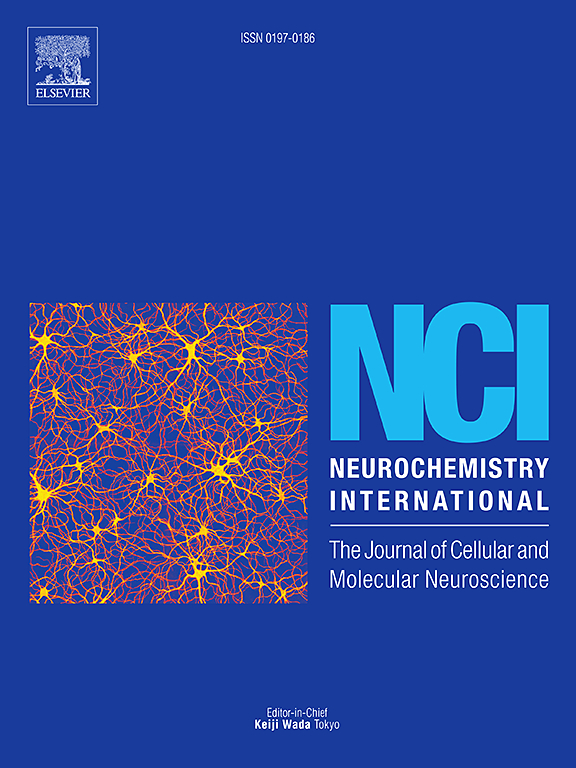Increased spinal adenosine after subacute cervical injury correlates with sustained upregulation of CD39 and CD73 in microglia
IF 4
3区 医学
Q2 BIOCHEMISTRY & MOLECULAR BIOLOGY
引用次数: 0
Abstract
Cervical spinal cord injuries (cSCI) are associated with decreased breathing ability. Although no treatment options are currently available, moderate acute intermittent hypoxia (mAIH) is a promising therapeutic modality to improve breathing function after cSCI. Moderate AIH elicits phrenic motor plasticity via distinct, competing serotonin- or adenosine-driven mechanisms that interact via powerful crosstalk inhibition that constrains or even abolishes plasticity. The dominant mechanism driving plasticity depends on the spinal serotonin/adenosine balance. Shortly after cSCI, repeated AIH exposure elicits plasticity via an adenosine-dependent mechanism but reverts to serotonin-dominance with chronic cSCI. In healthy CNS, microglia regulate AIH-induced phrenic motor plasticity via enzymatic activities of ectonucleotidases (CD39, CD73) by converting extracellular ATP to adenosine. We hypothesized that cSCI increases microglial ectonucleotidase expression, elevating adenosine levels that may alter therapeutic responses to mAIH post-cSCI. We assessed microglial CD39 and CD73 expression at the subacute (1 & 2 weeks) and chronic (8 weeks) stages post C2-hemisection, both at the injury site (C1–C3) and in spinal segments containing phrenic motor neurons below the injury (C3–C6). Both enzymes were upregulated (mRNA & protein) 1- and 2-weeks post injury but returned to baseline by 8 weeks. In association, spinal adenosine increased significantly at 2, but not 8 weeks post-injury. Further, microglial CD39 and CD73 expression strongly correlate with P2Y12 receptor expression. Thus, shifting adenosine levels between subacute and early chronic cSCI may impact mechanism regulating mAIH-induced respiratory motor plasticity and breathing recovery at different times post-cSCI.
亚急性颈椎损伤后脊髓腺苷增加与小胶质细胞中CD39和CD73的持续上调有关
颈脊髓损伤(cSCI)与呼吸能力下降有关。虽然目前没有治疗方案,但中度急性间歇缺氧(mAIH)是一种有希望改善cSCI后呼吸功能的治疗方式。中度AIH通过不同的、相互竞争的5 -羟色胺或腺苷驱动机制引发膈肌运动可塑性,这些机制通过强大的串扰抑制相互作用,限制甚至消除可塑性。驱动可塑性的主要机制取决于脊髓血清素/腺苷平衡。慢性脊髓损伤后不久,反复的AIH暴露通过腺苷依赖机制引起可塑性,但慢性脊髓损伤患者恢复到5 -羟色胺主导。在健康的中枢神经系统中,小胶质细胞通过胞外ATP转化为腺苷,通过胞外核苷酸酶(CD39, CD73)的酶活性调节aih诱导的膈肌运动可塑性。我们假设cSCI增加了小胶质外核苷酶的表达,提高了腺苷水平,这可能会改变cSCI后对mah的治疗反应。我们评估了亚急性(1 &;在损伤部位(C1-C3)和损伤下方包含膈运动神经元的脊髓节段(C3-C6), c2半切后2周和慢性(8周)分期。两种酶均上调(mRNA &;蛋白)损伤后1周和2周,但8周后恢复到基线。与此相关的是,脊髓腺苷在损伤后2周显著增加,而不是8周。此外,小胶质细胞CD39和CD73的表达与P2Y12受体的表达密切相关。因此,亚急性和早期慢性cSCI之间腺苷水平的变化可能影响mah诱导的cSCI后不同时间呼吸运动可塑性和呼吸恢复的调节机制。
本文章由计算机程序翻译,如有差异,请以英文原文为准。
求助全文
约1分钟内获得全文
求助全文
来源期刊

Neurochemistry international
医学-神经科学
CiteScore
8.40
自引率
2.40%
发文量
128
审稿时长
37 days
期刊介绍:
Neurochemistry International is devoted to the rapid publication of outstanding original articles and timely reviews in neurochemistry. Manuscripts on a broad range of topics will be considered, including molecular and cellular neurochemistry, neuropharmacology and genetic aspects of CNS function, neuroimmunology, metabolism as well as the neurochemistry of neurological and psychiatric disorders of the CNS.
 求助内容:
求助内容: 应助结果提醒方式:
应助结果提醒方式:


